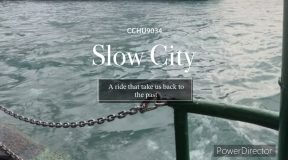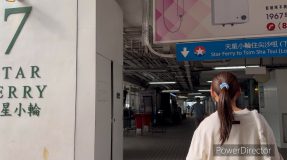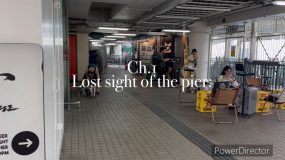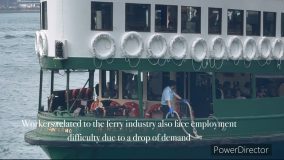Video link : https://youtu.be/NCZrlnHKMd8
Star ferry is an iconic and historical transportation system in Hong Kong with over 140 years of history. Star ferry incorporates the theme of continuation in an era of constant changes.
Being the first public ferry service, it represents the historical connection between Hong Kong Island and the Kowloon Peninsula, and the Chinese Territory beyond it. The star ferry symbolizes the historical and cultural significance of this bustling city. It has witnessed the transformation of Hong Kong from a small fishing village into an international financial center, accompanying Hong Kong people of different generations throughout different major historical events like the British colonization. Despite such a big transformation, Star ferry still continues to serve the public. Not only is it a means of transport, but a linkage of the past to the present, connecting people of different generations served by the star ferry. The distinctive green and white ferries sailing across the Victoria Harbour also become a synonymous cityscape captured in tourists’ photographs, paintings and films, becoming a symbol of Hong Kong’s culture and identity. Star ferry matters as a historical, cultural integration and tourist attraction, which holds a significant importance in Hong Kong.
Star ferry operates in the setting of Victoria Harbour. It serves to provide a reliable and efficient transportation for locals and tourists to go across the Victoria Harbour. Passengers can enjoy the breathtaking skyline and famous buildings of Hong Kong, allowing them to appreciate the beauty of this color-filled metropolis . The setting provides a mesmerizing backdrop to the ferry’s journey, adding magnificence and extravaganza to the star ferry experience. In order to be more easily accessed by locals and tourists, the ferry piers are located at Tsim Sha Tsui and the Central. The 2 piers are strategically located near tourist attractions. commercial center and transportation hubs, welcoming people to embark on a journey filled with glitz and glamor.
The charm and character of Star Ferry is inevitably attributed to the component of the ferry. The double-decker ferries painted in distinctive green and white offer passengers a different experience. Passengers can choose whether they choose to sit at the upper deck where they can enjoy the fresh harbor breeze or the lower deck where shelters are provided for a comfy and calm ride. The ferries are not air-conditioned, equipped with wooden chairs, and are diesel-powered; these components contribute to the star ferry’s nostalgic and historic image.
Research Method
(a) Online literature research
Though Star ferry has an irreplaceable place in every Hong Kong people’s heart, the ferry business started to go downhill in the past few years. People hypothesize that the demise of ferry transport in Hong Kong is largely due to competition with fixed link connections to islands, reclamation, and pier relocation, compounded by a lack of government support. Coupled with the shift in Hong Kong transport policy of railway being the backbone of transportation, ferries are no longer an essential and popular transportation. Other transportation such as MTR and buses can go across Victoria Harbour due to the construction of the cross-harbour tunnel. This slow-paced ferry transport’s popularity then started to diminish and being forgotten by the public since high-speed services and good frequency are important for maintaining public transport passenger numbers .
(b) Field trip observation
After reading various literature regarding the reason for the decline of Star ferry, a field trip observation was done. My field investigation observes the flow of people at the pier and the shops nearby. I’ve chosen a morning session where the time and weather are suitable for a ride on the star ferry. However, after a 2-hour observation, I can barely see people entering the pier. Most of the people walk past the pier and walk to the bus terminal and MTR station at a fast pace, which is at the opposite of the central pier. while some tourists only check in at the pier but not taking a ride. It is also noticed that the shops situated inside the pier have poor business as barely will people walk into the pier. When I get on the boat, it can also be clearly seen that the interior is very dilapidated and old, the major passengers on the ferry are elderly and some tourists.
Technique:
For the opening, I’ve used a hip level shot to shoot the splashing waves generated when the ferry was moving across Victoria Harbour. Then it is followed by a shoulder level shot for the star ferry docking to the pier, allowing the audience to have a look of the operating star ferry.


While walking into the pier, I used a pan and tilt camera movement to film using a tracking shot to present the desertedness of the terminal.

I used a pan movement and time-lapse filming with a shoulder angle to film an overview of the terminal to tell the audience that most of the shops around terminal were seriously affected by the diminishing star ferry service. Moreover, i also shot some close shot of workers of the star ferry company to tell that if star ferry vanished, these stakeholders will also be seriously affected.


I used a point-of-view shot to shoot the environment of the terminal to let the audience have an experience of being a passenger entering the pier.

I used a tilt movement switching from a ground level to knee level to film the motion of boarding onto the ferry.

i used another pan movement with a middle shoot to show audience that the interior of the ferry is very old and nostalgic

The last shot is a close shot of the funnel exhausting black smoke, which symbolizes the future of star ferry is just as gray as the smoke.

As the Chief Executive Donald Tsang said in a radio programme in January 2007, ‘we cannot afford heritage preservation if we do not preserve our economic sustainability’ and ‘continued economic prosperity depends on new buildings being built and old ones replaced.’ It can be clearly seen that the government prioritize economy over culture preservation. If government and the public don’t face and solve the current situation of star ferry, it is undoubtedly that star ferry might vanish in 1 day.
bibilography:
Star Ferry, ‘Emblem of Hong Kong,’ May Sail Into History After 142 Years The New York Times https://www.nytimes.com/2022/04/19/world/asia/hong-kong-star-ferry.html
Leung, A., Tanko, M., Burke, M., & Shui, C. S. (2017). Bridges, tunnels, and ferries: connectivity, transport, and the future of Hong Kong’s outlying islands. Island Studies Journal, 12(2), 61–82. https://doi.org/10.24043/isj.24
Walker, J. (2012). Human transit: how clearer thinking about public transit can enrich our communities and our lives. Washington, DC: Island Press. https://doi.org/10.5822/978-1-61091-174-0
Ku, A. S. (2012). Remaking Places and Fashioning an Opposition Discourse: Struggle over the Star Ferry Pier and the Queen’s Pier in Hong Kong. Environment and Planning. D, Society and Space/Environment and Planning. D, Society & Space, 30(1), 5–22. https://doi.org/10.1068/d16409
Ho Hoi Ying UID: 3036220424
Hi! I like your way of separating the video into two chapters and it made the video more organized and easy to understand. It is nice to use different angles of shot throughout the video. For some suggestions, I think there is some incoherence in between two frames, so maybe the editing part could be improved. Also, for the last shot of smoke, it maybe better to zoom in and emphasize the smoke only. I chose to make the video of ‘fast’ city, but your about ‘slow’ city indeed convinced me! It is overall a good piece!